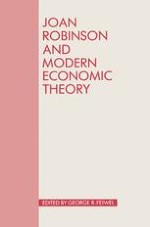1989 | OriginalPaper | Buchkapitel
Demand Composition, Income Distribution, and Growth
verfasst von : Lance Taylor
Erschienen in: Joan Robinson and Modern Economic Theory
Verlag: Palgrave Macmillan UK
Enthalten in: Professional Book Archive
Aktivieren Sie unsere intelligente Suche, um passende Fachinhalte oder Patente zu finden.
Wählen Sie Textabschnitte aus um mit Künstlicher Intelligenz passenden Patente zu finden. powered by
Markieren Sie Textabschnitte, um KI-gestützt weitere passende Inhalte zu finden. powered by
An enduring theme in Cambridge economics — and Joan Robinson’s work in particular — is that the overall macroeconomic situation is intimately linked with income distribution. Following in Robinson’s footsteps, Row-thorn (1982), Taylor (1983), and Dutt (1984) have recently presented models of how growth and distribution interact in a one-sector setting, under two alternative modes of macroeconomic adjustment. The first is based on changes in output or capacity utilization, along lines stressed by Keynes in the General Theory, and Kalecki (1971) and his followers. One striking Kaleckian result is that income redistribution favoring workers may lead to higher capacity utilization and faster growth. The second, ‘neo-Keynesian’ adjustment mechanism functions via income redistribution to create forced saving in response to higher investment demand. In such models (as proposed by Keynes in his Treatise on Money; Kaldor, 1960; and Robinson, 1962, for example) faster growth is necessarily associated with an endogenous distributional shift away from labor. The tenor of these results carries over when inflationary mechanisms and financial markets are brought into the models — see Marglin (1984) and Taylor (1985) for neo-Keynesian and Kaleckian variants, respectively.
